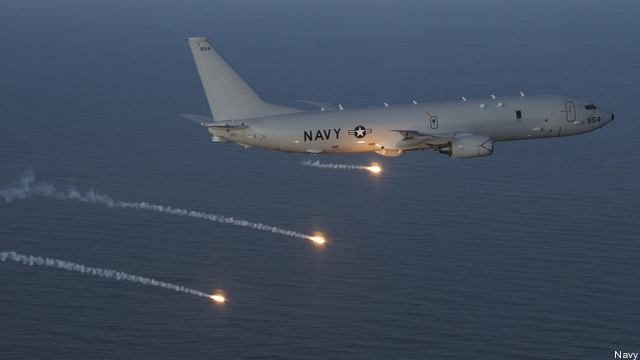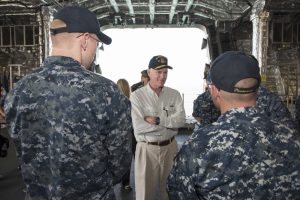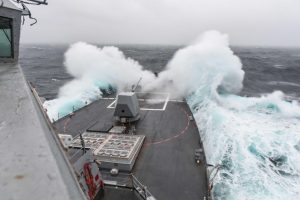Navy Looking To Fly P-8s From Cold War-era Base In Alaska
WASHINGTON: The Navy may begin deploying submarine-hunting P-8 Poseidon aircraft to a small airstrip hundreds of miles off the Alaskan coast, signaling a new emphasis on keeping watch over Russian and Chinese moves in the Arctic.
The remote runway sits on the island of Adak in the Aleutian island chain, and it’s the westernmost airfield that can handle passenger aircraft in the United States — in fact, it currently handles Air Alaska flights two days a week.
Formally known as Naval Air Facility Adak, the small airport has been operating commercially since the Navy moved out in 1997, but increasing Russian and Chinese activity in the Arctic has the Navy looking at new patrols as it searches for ways to keep a closer watch on the far north.
Navy officials previously estimated that reopening the base would cost around $1.3 billion, but Navy Secretary Richard Spencer indicated Wednesday at a joint hearingof the Senate subcommittees on sea power and readiness & management that he isn’t looking to reopen the entire facility.
“The airstrip is in great shape,” Spencer said after the hearing when I asked about flying aircraft from the island. The Navy would likely have to pay to clean up one of the hangers, but the airport “has a fuel farm up there that Air Alaska is using to fuel its planes, it has de-icing platforms that we could use for fresh water washdowns for the P-8. They have lodging up there that is supposedly coming forward to us on a rental availability, so it really isn’t a big bill.”
In recent years the US has spent millions of dollars to fix up another Cold War-era airfield, Naval Air Station Keflavik in Iceland, to accommodate P-8s watching for Russian submarine activity in the North Atlantic between Greenland, Iceland, and the United Kingdom. These waterways, dubbed the GIUK Gap, are the primary outlet for Russian subs moving from their northern ports into the Atlantic.
The Pentagon has grown increasingly concerned over ceding ground to Russia and China in the Arctic, as both countries are outpacing the US in building icebreakers to help move ships and supplies to far-flung outposts as the region’s ice disappears due to global warming.
Spencer told lawmakers “our Russian friends are warming up five airstrips and 10,000 Spetsnaz troops [in the Arctic] for quote unquote search and rescue. The Chinese are up there. Everybody is up there.”
“Everybody but us,” retorted Alaska Sen. Dan Sullivan.
“We are up there under the sea and in the air,” Spencer said, adding that the Navy is working with the Coast Guard to devise ways to conduct more training missions in the far north and identify ports that could accommodate Navy ships.
“If I had a at blank check for everything, it would be terrific to ice-harden ships but with the demand we have right now it is unaffordable,” Spencer told lawmakers. But “we need to get up there. I can commit to the fact that we’re trying to figure out how we do service that.”
The Navy isn’t the only service looking to beef up its presence in Alaska. The Air Force suggested recently it is looking to move some of the F-22s made homeless after Hurricane Michael battered Tyndall Air Base in Florida to Alaska’s Joint Base Elmendorf-Richardson.
During an August visit to the state, Defense Secretary James Mattis pledged “America has got to up its game in the Arctic” given the melting of the polar ice caps and the rush to find long-hidden natural resources in the region.
In many ways, the Navy is already on the move. In November, the USS Harry S. Truman aircraft carrier cruised above the Arctic Circle, the first time an American carrier moved that far north since the Cold War. The carrier strike group was taking part in NATO’s Trident Junctureexercise, which saw ships and sailors get battered by the rough, cold seas.
“We’ve been operating in the Persian Gulf, where it’s like a lake, and it’s really hot, whereas now we’re operating up off the coast of Norway, where it’s blowing a gale, the decks are moving around, the ships are getting beat up, and the people are getting beat up,” said Vice Adm. Andrew Lewis, commander of the Navy’s newly reconstituted 2nd Fleet, last month.
Lewis’ command will focus on operations in the Atlantic, where Russia has been more active as it expands and modernizes its force. “We’re not used to being out on the flight deck for long periods of time where it’s really cold,” Lewis added.
Adak, a 3-hour flight west from Anchorage deep in the Bering Sea, would allow US aircraft to not only push deeper and more consistently into the Arctic, but give US spy planes a new base from which to keep an eye on Russia’s Pacific Fleet and the increasing number of Chinese subs prowling the Pacific.
The potential new deployments come as the US is actively shifting its gaze to the Pacific after two decades of grinding conflict in the Middle East.
Washington’s allies in the region are also snapping up US-made surveillance planes to track increased Chinese activity, as well. In September, The State Department approved the $2.6 billion sale of six P-8A Poseidon aircraft to South Korea, and the $3.1 billion sale of nine E-2D Advanced Hawkeye Airborne Early Warning and Control aircraft to Japan.
Back to Top


